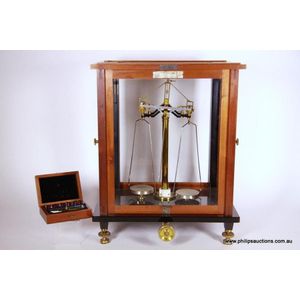Mahogany Corner Cabinet with Astragal Glazing and Pediment
You must be a subscriber, and be logged in to view price and dealer details.
Subscribe Now to view actual auction price for this item
When you subscribe, you have the option of setting the currency in which to display prices to $Au, $US, $NZ or Stg.
- Mahogany - Mahogany is a dense, close grained red-coloured timber from the West Indies and Central America. It was first imported into Europe in the the early 18th century and its use continued through the 19th century. It was popular for furniture making because of its strength, the wide boards available, the distinctive grain on some boards, termed flame mahogany and the rich warm colour of the timber when it was polished.. The "flame" was produced where a limb grew out from the trunk of the tree, and this timber was usually sliced into veneers for feature panels on doors, backs and cornices.
Some terms used to describe mahogany relate to the country from which it originally came, such as "Cuban" mahogany, "Honduras" mahogany etc. However unless the wood has been tested the names assigned are more a selling feature, rather than a true indication of the timber's origin. - Astragal / Glazing Bars - An astragal, bead or glazing bar is the term used to describe the wooden strips that divide the glass in a cabinet into sections. However it can also refer to the narrow beading on a multi-door cabinet or bookcase that covers the gap between the doors, when they are closed. The astragal is usually attached to the inner stile of the left-hand door (or the right hand as you look at it).
- Pediment - The uppermost section of a tall usually double-heightened piece of cabinet furniture, surmounting the cornice. The pediment can take a variety of forms derived from the architecture of classical antiquity. A broken pediment is of triangular shape, however, the two raised sides do not meet at the apex but are 'broken' the gap between them often ornamented with an urn or finial. Swan-neck pediments are of similar form, although the uprights are gracefully arched, resembling a swan's neck. They are often found, for example, on longcase clocks.
This item has been included into following indexes:
Visually similar items

A 19th century hanging corner cabinet with astragal glazing, three tiered shelf, 119 cm high and 50 cm deep

An Edwardian mahogany and fruitwood inlaid wall-mounted corner cabinet with broken arch pediment, astragal glazed door. Width 64 cm

A Georgian mahogany hanging corner cabinet with an astragal glazed door, green painted interior with three shelves, swan neck pediment and restrained banded inlay. The pediment with fault. With key. 75 x 42 x 123 cm

A set of German GPW gold weighing scales, made by Gottinger Prazisionswagen Fabrik for H.B. Selby & Co Pty Ltd, Melbourne and Sydney, specialist importers and manufacturers of scientific instruments 1930s-1983, the precision brass balance scales housed in
